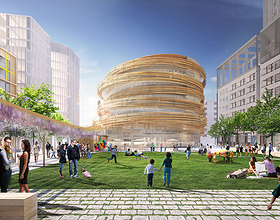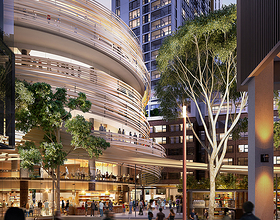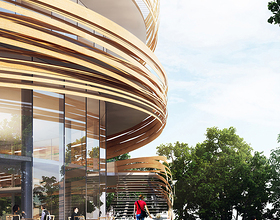THE DARLING EXCHANGE
-
The project is a multi-use building comprised of pubic, childcare, library and commercial uses, including a fresh food market and restaurant. It was planned as a part of the large urban development in the active area of Darling Harbor, Sydney.
The site within the development is like a small pocket among high rise buildings and is characterized by rigid geometry and hard surfaces. The urban design strategy for The Darling Exchange is to create an architectural form in harmony with the square which can merge with the landscape and preserve a human scale using natural materials to produce a tangible and comfortable building.
Surrounded by residential blocks, retail at the lower levels, and an active flow of people along the boulevard, the site is a nodal point. They therefore chose a non-directional architectural form so that it would be accessible and recognizable from all directions. The circular form reflects and promotes the vibrant and active neighbourhood of the Darling Square Precinct with its diverse mix of users.
The ground floor plane is conceived as an extension of the Square. A fully glazed façade enables the space to be open, transparent and accessible from all directions. It promotes interaction with active street life and free flow of people offering opportunities for the community’s daily use. Middle levels of the building are dedicated for public use. To express the active and diverse nature of the building, a dynamic geometry was created through a shifting of floor plates. By shifting floor plates, comfortable and active outdoor terraces are created at each level that suit the use for its function.
Timber was selected for the building envelope in order to offer natural texture to the neighbours. An organic and spontaneous timber screen wraps around the shifting floor plates. The timber strips filter the natural light and provide a soft texture to the interior space. It is their intent to express architecture as a part of natural elements, like a tree or a “nest” in playful and primitive manner.
Photo credits: Kengo Kuma & Associates
1870 Projects









